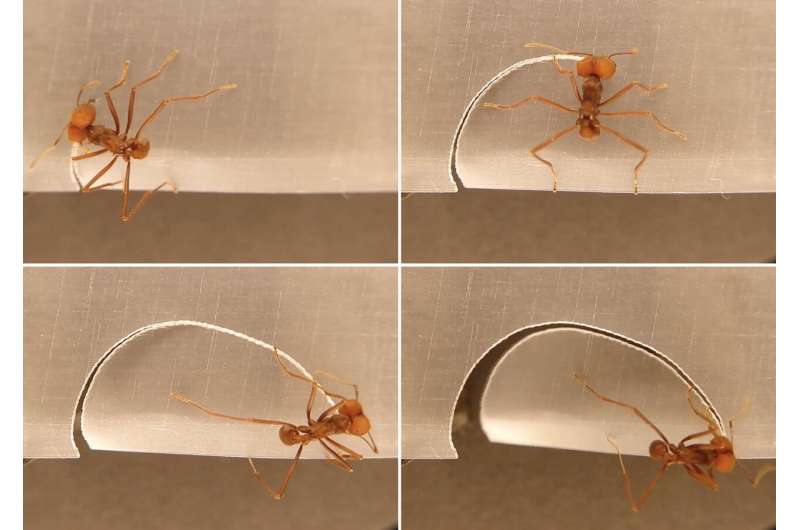This article has been reviewed according to Science X's editorial process and policies. Editors have highlighted the following attributes while ensuring the content's credibility:
fact-checked
peer-reviewed publication
trusted source
proofread
Study reveals how leaf-cutting ants gauge leaf portion size

They might not be able to leap tall buildings with a single bound, but leaf-cutting ants are insect superheroes, capable of carrying leaf pieces up to six times their body mass to cultivate fungus in their borrows. But how do the charismatic creatures determine the size of the fragments they carve with their mandibles?
Do they use their bodies as a simple ruler, or do they use information about the position of their bodies to adjust how far they cut, adapting to the thickness of a leaf while dismembering it?
Knowing that the insects alter the trajectory of a cut when sculpting Parafilm of different thicknesses, Flavio Roces from the University of Würzburg, Germany, decided to find out how the ants govern the size of the portions they trim. He and his colleagues, Daniela Römer and Rebecca Exl (also from University of Würzburg), have published their discovery in Journal of Experimental Biology that each ant keeps track of the position of the leaf edge by gripping it with their rear legs while pivoting their bodies as they trim to cut perfect leaf portions.
The researchers first needed to understand with how the insects snip out regular leaf fragments. Exl fashioned fake leaves from Parafilm—one layer for thin leaves (0.13 mm), three for thick leaves (0.38 mm)—rubbed them with crushed bramble leaves or rose oil to make them more appealing to the ants and installed them in the foraging area of a lab-based Atta sexdens ant colony. As soon as an ant climbed aboard, Exl retrieved the pseudoleaf and positioned it in front of a camera to record the ant's maneuvers.
Initially, the ant lay along the edge of the leaf, with the hind and middle leg on the side nearest the edge gripping the Parafilm. Then, it snipped upward, gradually rotating its body until upright as it cut in an arc, attaching the second hind limb when its body was almost vertical.
As the ant continued cutting, it rotated further, eventually releasing the first hind limb from the leaf edge while still holding on with the second hind limb, until it severed the chunk by cutting through the leaf edge after swiveling the body through 180 deg. And when Exl compared the ants' posture as they cut through thick and thin leaves, she realized that they adapted their technique, crouching their legs to reduce their reach to cut smaller elliptically shaped fragments when provided with thick leaves.
So how were the ants controlling the size of the fragments they incised? Could knowledge about the position of their hind legs gripping the leaf edge guide their cutting trajectory? This time, Exl waited until each ant was halfway through a cut before gently inserting a piece of paper between the ant and the fake leaf to release its grip as it continued snipping.
Without knowledge of the position of their legs relative to the leaf edge, some of the ants cut smaller elliptical portions. They were using information provided by their hind legs gripping the leaf edge to guide the trajectory of their cut. However, some ants were still able to cut similarly sized fragments. Were they using some other sensory information to guide their trajectory? Could hairs at the front of the neck, which detect the position of the head, contribute to their sense of cutting direction?
Exl cautiously shaved off these hairs and allowed the ants to cut a Parafilm leaf while gently detaching the insect's limbs from the edge with the paper guard, and this time the ants completely lost track of direction, producing randomly shaped fragments that were nothing like the elliptical pieces they had cut previously.
This implies leaf-cutting ants depend on knowledge of the location of the leaf edge provided by their legs, and the position of their heads, to keep them cutting on the curve and ensure that they never excise fragments that exceed their exceptional strength.
More information: Flavio Roces et al, Two feedback mechanisms involved in the control of leaf fragment size in leaf-cutting ants., Journal of Experimental Biology (2023). DOI: 10.1242/jeb.244246 , journals.biologists.com/jeb/ar … i/10.1242/jeb.244246
Journal information: Journal of Experimental Biology
Provided by The Company of Biologists



















